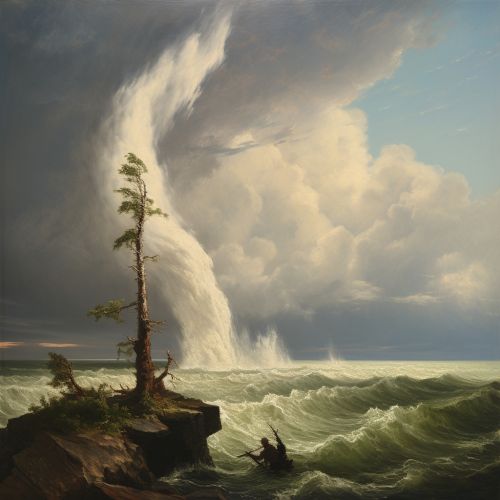Waterspout
Introduction
A waterspout is a non-supercell tornado over an open body of water. Connected to a cumuliform cloud or a cumulonimbus cloud, it is often accompanied by high winds and seas, large hail, and frequent dangerous lightning. Waterspouts are closely related to other atmospheric phenomena such as tornadoes, hurricanes, and cyclones. However, they are unique in their formation, characteristics, and impact.


Formation
Waterspouts exist on a microscale, where their environment is less than two kilometers in width. The life cycle of a waterspout, like that of tornadoes, consists of five stages: formation of a dark spot on the water surface, spiral pattern on the water, formation of a spray ring, development of the visible condensation funnel, and ultimately, decay.
Dark Spot
A prominent circular, light-colored disk appears on the surface of the water, surrounded by a larger dark area of indeterminate shape and with diffused edges. This dark spot is the first visible sign of a waterspout.
Spiral Pattern
A pattern of light and dark-colored bands spiraling out from the dark spot develops. This pattern is the surface manifestation of the intensifying circulation.
Spray Ring
As the circulation continues to intensify and the upward motion increases, sea spray is pulled upward from the dark spot. This spray appears to be a brilliant white ring of cascading water droplets.
Mature Vortex
The waterspout, now a mature vortex, is in its most severe stage. The spray vortex can rise to the base of the cloud and the spray ring can climb up the waterspout's vortex.
Decay
The final stage of a waterspout's life cycle is the decay stage. It occurs when the inflow of warm air into the vortex weakens, which can occur for a number of reasons. This stage is often observed as a narrowing of the condensation funnel and weakening of the spray vortex, until the waterspout finally dissipates.
Types of Waterspouts
There are two types of waterspouts: tornadic waterspouts and fair-weather waterspouts.
Tornadic Waterspouts
Tornadic waterspouts are essentially tornadoes over water. They form over water, or move from land to water. They have the same characteristics as a land tornado and are associated with severe thunderstorms, and large-scale weather systems such as severe weather fronts.
Fair-Weather Waterspouts
Fair-weather waterspouts, on the other hand, are not associated with thunderstorms. They form in light wind conditions so they normally move very little. Fair-weather waterspouts form at the base of cumulus clouds.
Impact on Society
While waterspouts are typically weaker than land tornadoes, they still pose a significant threat. They can overturn boats, damage larger ships, do significant damage when hitting land, and draw lightweight airborne objects, such as people, into their vortex if they pass too closely above them.
